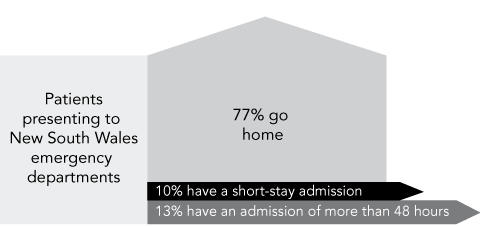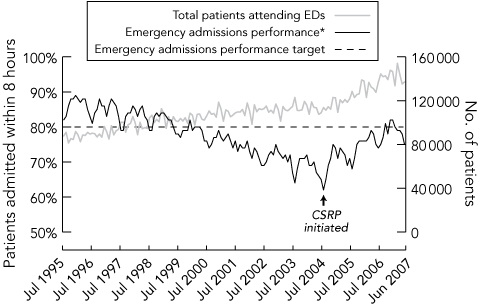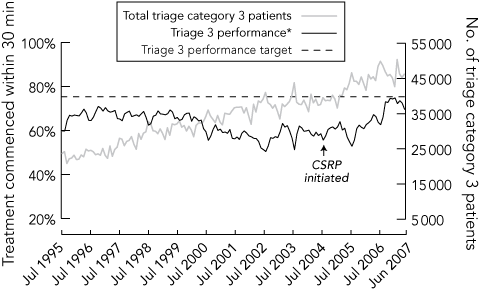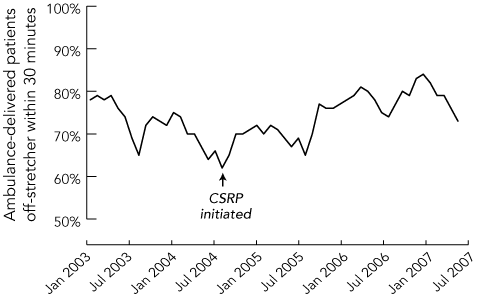Australian public hospital emergency departments (EDs) have recently been experiencing an overwhelming growth in demand for unplanned care: in New South Wales ED attendances are up 6.5% (Tony Dunn Director, Data Analysis and Performance Evaluation Branch, NSW Health, personal communication). The most obvious sign of this is a queue of patients on ambulance trolleys, waiting for a bed in the ED. The challenges facing Australian EDs have been described previously in this Journal, and include lack of access to inpatient beds, workforce deficiencies,1 safety issues,2 increased mortality,3,4 and inefficiencies that compound each other. The volume of demand for beds for patients being admitted from the ED often also resulted in a destructive impact on elective surgery.5
ambulatory patients were complaining that little information is given about reasons for their long waits or how much longer they will have to wait;
patients’ uncertainty and frustration is often expressed by anger and aggression toward staff, or by not waiting to be seen by a doctor;
patients in an ED who needed to be admitted to hospital sometimes waited days before being transferred to a ward;
patients were often not admitted to their specialist team’s home ward;
staff in busy EDs often felt under siege, and there was a mind-set among hospital management and ED staff that if the ED is very busy, the best response is to reduce patient demand by not accepting ambulances, rather than to improve internal hospital processes;
when one hospital is busy, so are most hospitals in the vicinity;
the overall pattern of presentations to EDs is surprisingly predictable when analysed by season, day of week or hour of day (eg, hospitals are most often congested on Monday afternoons as occupancy peaks because of the combination of elective arrivals, ongoing emergency arrivals and the delayed departure of inpatients because the rate of discharge at weekends is reduced); and
congestion in ED is contributed to by inefficient flow of patients through the entire hospital, as well as inefficiencies within the ED.
Increasingly, patients in EDs are older6 and frail, with multiple problems that take many hours to assess. Such patients can be hard to place with medical teams, which have become increasingly specialised around single-organ diseases. Teams may not feel confident outside their subspecialty and may be reluctant to accept the patient. Another large patient group is people with chest pain, who are managed under treatment protocols that require them to wait many hours for tests to exclude a cardiac cause.
A large number of patients who have historically stayed in hospital for only 1–2 days have conditions such as cellulitis, deep vein thrombosis and community-acquired pneumonia that are amenable to safe management in the community using “hospital in the home” models.7 Home-based care can also be preferable for older people, who often become confused and debilitated in hospital. Other advantages of community-based care include the reduced risk of hospital-acquired complications, and that such care can replace the final portion of an otherwise longer hospital stay.
In NSW in the 2005–06 financial year, 40% of patients admitted to public hospitals came through EDs (Tony Dunn Director, Data Analysis and Performance Evaluation Branch, NSW Health, personal communication), and these patients are demanding on ED staff time. However, the number of patients attending EDs is over 2 million per annum in NSW, and 77% are not admitted (Box 1). Redesigning pathways for this large group is potentially very beneficial, as moving them quickly through the ED can reduce congestion and frustration and improve the safety of care. A number of care models have been used in NSW to achieve this effect, such as “fast track zones”, advanced practice nurses, and rapid assessment teams.
Fast track zones stream patients with conditions of lower urgency or complexity, especially those who are ambulatory, into a separate zone of the ED where they are attended by a separate group of ED staff. Having experienced staff in this zone permits rapid decision making and faster handling. Medical staff can be supplemented in this model by nurse practitioners and experienced physiotherapists (used at Liverpool Hospital for minor musculoskeletal conditions), who are able to efficiently and independently manage a large subset of these patients and achieve high patient satisfaction.8
Many patients require only a relatively short inpatient period of monitoring once their initial assessment and treatment has been completed. Ten per cent of ED attendances in NSW result in a hospital stay of less than 48 hours (Box 1). A number of hospitals have established wards where short-stay patients are managed together, grouped by their likely duration of stay or other characteristics. This can improve the quality of the patient experience and reduce time spent in hospital.
The challenge for hospitals in managing patients who stay more than 48 hours is to guarantee processes that support smooth flow through the hospital from presentation to discharge, with minimal waste of time and effort. In NSW, 13% of ED attendances result in hospital stays longer than 48 hours (Box 1).
Electronic ambulance arrivals boards, linked to ambulance control rooms, can alert ED staff to imminent arrivals and to pending surges in demand.
Use of non-clinical staff, a better staff skill mix and clearer allocation of roles according to skills can allow tasks to be performed by the appropriate category of staff, thus freeing more highly trained staff for tasks that only they can undertake.
Identifying a manager who is responsible for overseeing patient flows in the ED and redistributing workloads or activating escalation plans at peak periods. For a complex system such as an ED to function well in the face of high and fluctuating levels of demand, staff need a clear chain of command.
Processes in the wards that “pull” patients who need admission out of the ED to the wards, rather than waiting until there is an overflow in the ED causing a “spill” or “push” of patients from the ED to the wards. This requires cooperation between nurse unit managers to facilitate transfer of patients.
Regular review and modification of bed allocations to minimise “outlier” patients (those in a ward that is not the designated ward for their condition). This is an essential step, although often contentious, as number of beds is seen to equate to the status of a unit. It benefits clinicians by reducing time spent travelling between wards, and ensures skilled teams who are familiar with the patient’s disease manage the patient. The benefits to patients include a better journey and higher quality care with reduced errors and fewer delays.
A daily morning ward meeting, led by the nurse manager, where medical, nursing and allied health staff meet for a short focused discussion of each patient. The patient’s journey is reviewed to determine what needs to happen next, and who will do what, by when. This ensures better coordination, and that clear work plans are made for the day, thus reducing the number of frustrating telephone calls to gather and share information.
Information technology solutions such as a hospital electronic bed board have also been found to be effective. They provide bed managers and nurse unit managers with a clear picture of pending emergency and elective demand, and of available capacity. We have introduced electronic bed boards in over 100 hospitals in NSW.
Universal discharge planning, with all patients having an estimated date of discharge from the time of admission. This allows better preparation for discharge, ensuring all referrals have been prepared, medications are ready, and carers are prepared to receive the patient at home.
Admission rules to guarantee that all patients (especially those who have complex, multiple problems) are rapidly allocated a specialist.
Clear rules about how ED staff will communicate with in-patient teams (including accountability for decisions about patients) and commitment from inpatient teams to rapidly attend the ED as needed.
Direct admission to the appropriate specialty ward for patients with chronic disease who are well known to the hospital. This avoids patients having to wait and repeat their complex medical history and ensures they are treated by the team who know them.
Access to accurate, current data for clinical staff and hospital managers to interpret patient flows through the hospital.
Real-time analysis of performance and the ability to establish the root causes of patient flow blockages are crucial. Having a patient flow unit reporting to an accountable senior manager is an important component of a well managed system.
More efficient communication between teams through the use of mobile phones and other new technologies, thereby delivering the right care to patients in a timely manner. This improves patient flow and also reduces staff frustration.
Overall statewide performance on emergency access key performance indicators (KPIs) has “turned around” since the implementation of the Clinical Services Redesign Program commenced in NSW in August 2004. Performance for the three most challenging KPIs, emergency admission performance (percentage of patients admitted through the ED who egress from the ED within 8 hours), triage 3 performance (percentage of patients in triage category 3 whose treatment is commenced within 30 minutes of arrival), and off-stretcher time (percentage of patients moved off an ambulance stretcher into an ED bed within 30 minutes of arrival) had been progressively deteriorating before the implementation of solutions arising from redesign in August 2004. Since the Clinical Services Redesign Program was implemented, performance has been improving, as shown in Box 2, Box 3, and Box 4.
The performance of a sample of 19 NSW hospitals (including the 10 with the busiest EDs) that underwent redesign of emergency patient flow is detailed in Box 5, showing that even in the face of rising demand (of between 5% and 27%), performance improved or was maintained in 52 of 57 instances for the three KPIs presented.
1 Disposition of patients from New South Wales emergency departments
 | |||||||||||||||
|
Data covers 1.7 million NSW public emergency department attendances in the 2005–06 financial year. | |||||||||||||||
2 Emergency admission performance* in New South Wales hospitals, 1995–2007
 | |||||||||||||||
|
ED = emergency department. CSRP = Clinical Services Redesign Program. * Percentage of patients admitted through the ED who egress from the ED within 8 hours. | |||||||||||||||
3 Triage 3 performance* for New South Wales hospitals, 1995–2007
 | |||||||||||||||
4 Off-stretcher times* for New South Wales hospitals, 2002–2007
 | |||||||||||||||
- 1. Cameron PA, Campbell DA. Access block: problems and progress [editorial]. Med J Aust 2003; 178: 99-100. <MJA full text>
- 2. Cameron PA. Hospital overcrowding: a threat to patient safety [editorial]? Med J Aust 2006; 184: 203-204. <MJA full text>
- 3. Sprivulis PC, Da Silva J, Jacobs IG, et al. The association between hospital overcrowding and mortality among patients admitted via Western Australian emergency departments. Med J Aust 2006; 184: 208-212. <MJA full text>
- 4. Richardson DB. Patient mortality increased at 10 days associated with emergency department overcrowding. Med J Aust 2006; 184: 213-216. <MJA full text>
- 5. Schofield WN, Rubin GL, Piza M, et al. Cancellations of operations on the day of intended surgery at a major Australian referral hospital. Med J Aust 2005; 182: 612-615. <MJA full text>
- 6. Braitberg G. Emergency department overcrowding: dying to get in [editorial]? Med J Aust 2007; 187: 624-625. <MJA full text>
- 7. Australian Resource Centre for Healthcare Innovations. Community acute/post acute care (CAPAC). http://www.archi.net.au/e-library/build/moc/capac (accessed Dec 2007).
- 8. NSW Department of Health. Nurse practitioner project. Stage 3 final report. Sydney: NSW Department of Health, Dec 1995.





We thank the staff of NSW Health who have participated in the Clinical Services Redesign Program, and Professor John Marley for his editorial advice. We also acknowledge the role Dr Deborah Lloyd performed in editing this article and producing this supplement.
None identified.